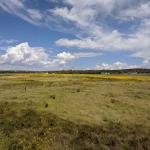Spiranthes magnicamporum (Great Plains Lady's Tresses)
| USFWS | State of NM | USFS | BLM | Navajo Nation | State Rank | Global Rank | R-E-D Code | NMRPTC Status | Strategy Status |
|---|---|---|---|---|---|---|---|---|---|
| E | S2 | G3G4 | D | SS |
| Overall Conservation Status | Documented Threats | Actions Needed |
|---|---|---|
| WEAKLY CONSERVED | Water management/use |
Trend monitoring. Document threats. Status assessment. |
Plants 7–60 cm. Roots few, descending, tuberous, mostly to 0.8 cm diam. Leaves fugaceous or rarely persisting to anthesis, basal, ascending, linear-lanceolate to oblanceolate, to 16 × 1.5 cm. Spikes usually very tightly spiraled, 3–4 flowers per cycle of spiral; rachis moderately pubescent, some trichomes capitate, glands obviously stalked (longest trichomes 0.2–0.52 mm). Flowers abruptly nodding from base, white to ivory, gaping, lip not strongly curving from claw, not urceolate; sepals distinct to base, 5–14 mm; lateral sepals wide-spreading, commonly ascending above flower; petals linear to lance-oblong, 4.9–13 mm, apex acute to obtuse; lip commonly yellow centrally, ovate to oblong, 4.9–12 × 3.3–7 mm, margins crenulate, glabrous; veins several, branches parallel; basal calli short-conic, mostly to 1 mm; viscidia linear-lanceolate; ovary 4–10 mm. In New Mexico flowering mid July to August
This plant is widely distributed in the Great Plains and Great Lakes regions north to Ontario, Canada. Rare in New Mexico.
Wetlands, cienegas, stream sides. In New Mexico from 4,560 ft to 6500 ft in elevation.
Documented impacts from herbicide use along a roadside in Santa Rosa; bulldozed in a wetland in Santa Rosa. Susceptible to collection, grazing, and wetland draining, and riparian improvement projects with herbicides.
For distribution maps and more information, visit Natural Heritage New Mexico



